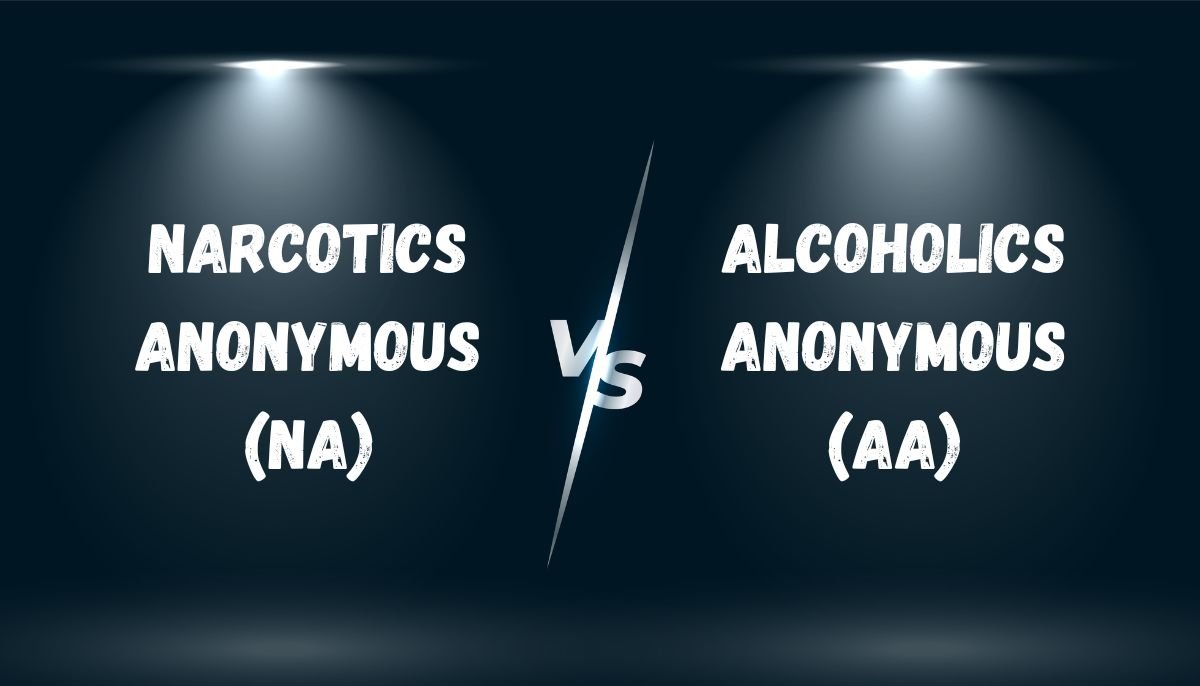Apples — lots of apples. Standing in the produce section of Stop & Shop on Saturday mornings, I find myself partly mesmerized and partly stressed out by the multitude of options I have. When it comes down to it, they’re all apples, right? But the differences in consistency and flavor are enough to give you pause. In the world of recovery, the sheer quantity of 12-Step programs present us with the same problem as my Saturday morning shopping adventures — which one to choose? But much like apples, some programs do stand above the rest (shout-out to Honeycrisp and Granny Smith).
Here, I’m going to give you a straightforward comparison of two of the most recognized recovery programs for individuals battling substance abuse, NA vs. AA. While both follow a 12-Step approach, the differences in flavor and consistency can help you decide which program is best suited for you.
What is Alcoholics Anonymous (AA)?
AA is a global fellowship that was founded in 1935 by Bill Wilson and Dr. Bob Smith, both of whom were struggling with alcoholism. The primary focus of AA is to help individuals achieve and maintain sobriety from alcohol. AA meetings are typically open to anyone with a desire to stop drinking, and anonymity is a cornerstone of the program. Meetings often involve sharing personal stories of struggle and recovery, as well as discussing the 12-step process and the “Big Book,” which is the foundational text of AA.
It would be borderline negligent if we missed this opportunity to compare Alcoholics Anonymous to the OG snacking apple — the Red Delicious. While missing the bells and whistles of more modern strains, it is responsible for solidifying the apple as the bagged-lunch staple we know it as today. More likely than not, it’s your grandma’s favorite. Ask her.
What is Narcotics Anonymous (NA)?
NA, founded in 1953, is modeled after AA but focuses on individuals dealing with drug addiction, including prescription drugs, heroin, cocaine, and other substances. NA meetings are similar to AA in that they offer a supportive environment for individuals to share their experiences and work through the 12 steps. Like AA, NA places a strong emphasis on anonymity and community, providing a safe space for individuals to seek help and support without judgment.
This one’s Honeycrisp. Why? Because if I’m snacking on apples it’s my personal favorite. And while you’re entitled to your opinion, deep down inside we all know Honeycrisp is the superior option (just kidding). But really, give them a shot. They’re good.
Similarities Between AA and NA
The NA vs. AA comparison gives rise to several common features. They both:
- Follow the 12-step program, which emphasizes personal accountability, spiritual growth, and making amends.
- Encourage attendees to seek sponsorship, where an experienced member guides and supports a newcomer through the recovery process.
- Provide a sense of community and peer support, offering a network of individuals who understand the struggles of addiction.
- Hold regular meetings that can be open or closed, depending on whether they are open to the public or restricted to those in recovery.
The Difference Between AA and NA
While the core principles are similar, there are some key differences between AA and NA:
- Focus of Recovery: AA specifically addresses recovery from alcoholism, while NA encompasses a broader range of substance abuse, including drugs and alcohol. NA tends to have a more inclusive focus on addiction in general, rather than limiting itself to alcohol-related recovery.
- Terminology: AA typically uses terms like “alcoholic” and “sober,” emphasizing abstinence from alcohol. NA, on the other hand, uses “addict” and “clean,” reflecting its focus on recovery from all substances, not just alcohol.
- Literature: The foundational texts are a major difference between NA and AA. AA’s core book is the “Big Book,” officially titled “Alcoholics Anonymous,” which outlines the 12-step program with a focus on alcohol addiction. NA’s primary text is the “Basic Text,” emphasizing recovery from drug addiction. While the general principles are similar, the content and examples in each text reflect their specific focus.
- Meeting Dynamics: Although both AA and NA conduct meetings based on the 12-step model, there can be subtle differences in meeting structure and style. AA meetings may be more traditional in approach, while NA meetings often encourage broader discussions about addiction, given their wider scope. The focus on alcohol or drug recovery influences the language and stories shared in each setting.
- Culture and Community: Because AA is older and has a more established presence, its culture might seem more formal or steeped in tradition. NA, being a younger organization, tends to be more flexible and may attract a different crowd due to its broader focus. Additionally, NA meetings can be more inclusive for those who have struggled with a variety of substances, creating a diverse community.
Choosing Between AA and NA
Choosing between NA vs. AA depends on your personal preferences, your addiction history, and what you’re looking for in a recovery program. Here are some simple guidelines you can use to help decide which might be a better fit for you:
- Type of Addiction: If your primary struggle is with alcohol, AA might be a more natural fit. If you’ve dealt with various drug addictions, NA may be more suitable. Some people attend both AA and NA meetings to cover all bases.
- Meeting Environment: Consider the vibe and structure of the meetings. Some people feel more comfortable in AA’s more traditional approach, while others prefer NA’s broader focus. Visit a few meetings to get a sense of the atmosphere.
- Location and Accessibility: Check the availability of AA and NA meetings in your area. If you have more AA meetings nearby, that could be a deciding factor, and vice versa.
- Personal Connections: If you know people who have found success in one program over the other, you might feel drawn to the same program.
Conclusion
Ultimately, when exploring the question of NA vs AA, the best program for you is the one that aligns with your needs, goals, and comfort level. I could compare and contrast different varieties of apples for you all day; I could talk about their texture, their density, and compare flavor profiles until the cows came home, but without trying the apples by tasting them, you’d be missing the most important component — your own experience.
Given the differences between the two programs, you might have already decided that one was clearly a better fit for you. But if not, I suggest attending a few different meetings from each program and get a taste for their unique flavor in regards to the 12-Step process. Just do yourself a favor and stay away from the Gala variety. This may be a hot take, but they’re mealy as hell and straight up bad.





